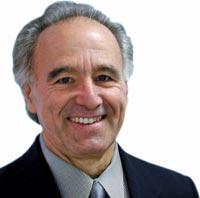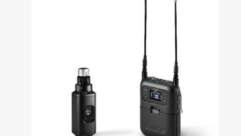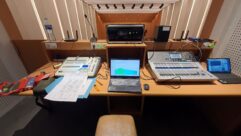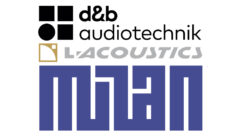

Peter D’Antonio, RPG Systems, on Acoustics
Peter D’Antonio, Ph.D., founded RPG Diffusor Systems in 1983. Over the years he’s pioneered the sound diffusion industry, earning various patents and trademarks. He is a fellow of the Acoustical Society of America and the Audio Engineering Society and a professional affiliate of the American Institute of Architects.
Performance spaces rely primarily on reflection and diffusion; small-room acoustics require primarily absorption and diffusion; whereas loud reverberant spaces require solely absorptive treatment. So if you want to remove the effects of strong specular reflections, whether it be in a performance space or small room, you would simply provide diffusion on the first bounce surface over an area comparable or somewhat larger than the wavelength of the lowest frequency at which you require diffusion.Sam: Your products differ from many audio products in that they are architectural in nature. This means dealing with architectural standards and practices that often have nothing to do with audio and acoustical requirements. Any insights?
D’Antonio: This is an important question. In the beginning, we simply designed diffusors using number theory sequences and essentially form followed function. Early on we realized that the appearance of a [quadratic residue diffuser], for example, while pleasing to some, might not be pleasing to everyone. So a concerted effort was made with Professor Cox to develop a software program that combined boundary element and multi-dimensional optimization techniques to allow us to create diffusive surfaces that were almost any shape. The program also offers the possibility of an acoustician or architect providing a proposed shape, which we can either virtually optimize or make in-scale using our rapid prototype printer and test on our goniometer.
Peter D’Antonio, Ph.D., founded RPG Diffusor Systems in 1983. Over the years he’s pioneered the sound diffusion industry, earning various patents and trademarks. He is a fellow of the Acoustical Society of America and the Audio Engineering Society and a professional affiliate of the American Institute of Architects.
Sam: You’re known as Dr. Diffuser, the man who brought well-researched, diffusive products to the audio market. How much diffusion is enough?
D’Antonio: It’s simple, you take the acoustical budget and divide it by the unit price of a diffusor and the quotient is the quantity needed! Just joking. If you want to be more scientifically rigorous, which I recommend, you need to think of using diffusors to control interfering reflections. A good design contains an appropriate combination of absorptive, reflective, and diffusive surfaces.
Credit: Peter D’Antonio
Sam: What is it about diffusive surfaces that your find so intriguing?
D’Antonio: Why would one devote 25 years of his life to studying surfaces that scatter sound? Good question. In the late 1970s, I built a recording studio to record original music. After consulting the literature like I would in my scientific career as a diffraction physicist, the only information I came up with was an approach called “Live End, Dead End,” which called for diffusion on the rear wall. Further research led to the work of Manfred Schroeder on reflection phase gratings.
To my surprise the RPG, as we now call them, were simply two-dimensional versions of three-dimensional crystals, which my research dealt with. Therefore, I was completely aware of the theory and could easily model, design, and over time optimize these surfaces. The accompanying simplicity and mathematical complexity, as well as their myriad uses have captured my imagination for 25 years. They allow me to combine my love of music and mathematics and enhance the ability to appreciate music and understand speech. I think of the acoustical palette, which consists of absorption, reflection, and diffusion, as I do the alphabet or the colors in a painter’s palette. Without one of the letters or one of the colors in the spectrum, many words or scenes could not be created. It’s the same with trying to design a space without diffusion.
Sam: Many of your products are specified by designers, which often puts you at least one step removed from the end user. Is this good or bad?
D’Antonio: RPG has always been primarily a business-to-business company, meaning our client is the designer/specifier and not the end user. The designer is typically an acoustician, although we often have to deal directly with architects. We make our research and proof-of-performance data available to specifiers and they integrate the appropriate product into their designs to achieve the performance for them to integrate into their concept of the project.
Sam: We use your products in configurations that others don’t. For example, we’ve been making custom, high-frequency diffusers that include mid-/low-frequency absorption from your FlutterFree products. Are you often surprised by what designers do with your products?
D’Antonio: No, we encourage experimentation because it may lead to incorporating a particular feature into our products. One of our goals, when possible, is to provide products that do several things simultaneously. In fact we are often add words to the acoustical lexicon like Abflector, Diffsorber, Abffusor, etc. We do this because, as in your example, we understand the importance of offering low-frequency absorption along with high-frequency diffusion.
Sam: Diffusive surfaces are well known as the rear-wall treatment of choice for recording studios. We’ve also seen diffusive surfaces for concert halls, churches, orchestra pits, even the rear wall/boundary of an outdoor amphitheater. Where do you see diffusion showing up next?
D’Antonio: I can’t describe how satisfying it is to witness the acceptance and broad range of applications in which diffusors have been used. To me, diffusors are an integral part of any space in which speech intelligibility or music appreciation is required. At the moment, schools are our largest market because they offer a microcosm or all our markets. Use may increase in these spaces as we introduce what we call “volume diffusors.” At the moment, diffusors are applied on surfaces. We have been researching and describe 3D, volume diffusors, as a possible new concept in the second edition of my book with co-author and professor Trevor Cox (“Acoustic Absorbers and Diffusers: Theory, Design and Application“, Taylor and Francis, 2009).
Sam Berkow
Sam: RPG has expanded its offerings to include materials for Isolation and stage acoustics. Will this require you to change the way you do business?
D’Antonio: No, because both sound and noise control products are essentially specified by the same acoustical consultants. Most of the projects we are involved with include noise and vibration isolation, so we felt that if we could provide innovative isolation products to complement our acoustically innovative products with the detailed documentation we have come to be know for, acousticians would entertain these new products. The goal has in fact been realized in that RPG is now considered by the acoustical community as a single source for both sound and noise control products.
Sam: When in comes to architectural acoustics, a very wise man once said, look to nature for the best solutions. Are there naturally occurring diffusive or absorptive surfaces that offer great performance?
D’Antonio: Nature is a constant source of inspiration, and fractal surfaces predominate. Therefore we have done quite a bit of research on fractal diffusors, the Diffractal being the first, in which the surface consists of nested scale replicas. A good analogy is a coaxial speaker in which we have a mid- and high-frequency component in the same entity. We have used this in many recording studios.
One of the concepts that has intrigued me is periodicity or repetition. Humans like the orderliness of, for example, a wallpaper pattern. While symmetry and periodicity are aesthetically pleasing, they are anathema acoustically, because they lead to scattering in specified grating directions, similar to what happens when you create an array of loudspeakers. We have recently devised ways to create acoustically optimal aperiodic surfaces, which appear to be visually periodic. Another intriguing phenomenon is the defect lattice, in which you have voids or imperfections. Researchers have found ways to utilize this phenomenon to create absorption and we have described a way to create volume diffusors using this concept.
Sam: Is it true you were a spy for many years?
D’Antonio: This is a serious allegation made by my colleagues and it has no basis in truth, although I suspect even my own family doubts this.
Sam Berkow is the founding partner of SIA Acoustics, an acoustical design firm with offices in New York and Hollywood, Calif.










